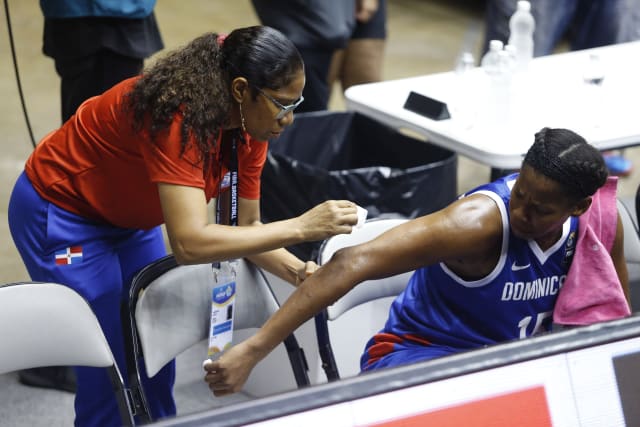Behind the scenes with the AmeriCup physical trainers who keep their players at a 100 percent
SAN JUAN (Puerto Rico) – Although it's true that the absolute of the FIBA Women’s AmeriCup are their players, there’s a supporting staff that makes it possible for these players to play to the best of
SAN JUAN (Puerto Rico) – Although it's true that the absolute of the FIBA Women’s AmeriCup are their players, there’s a supporting staff that makes it possible for these players to play to the best of their abilities. We're talking about the physical trainers, physical therapists and athletic trainers that work every day behind the scenes so that their national teams look spotless on the court.
These professionals have several responsibilities that start a well before the games; they prepare their players during practice sessions and when they are injured. The work lasts many hours after the game ends, which is when they then begin the recovery process for the next day. This, of course, is critical in a tournament like the FIBA Women’s AmeriCup, where they play up to six games in eight days.

“We're responsible for the health and wellbeing of our players so that they can perform better,” said Ed Ryan, athletic trainer to USA Basketball for 36 years. “The National Team has been very successful, and I've been very fortunate to be a part of these teams.”
It truly is an endeavor to hold in your hands – literally – the muscles, bones and joints of some of the best athletes in the world. Keeping them healthy on the court is a task that requires a lot of dedication, expertise and, above all, communication – both with the players and the technical staff.
For Fabián Amaya, physical trainer for the Puerto Rico national team for the second year in a row and programming specialist for high-performance athletes, his work is essential for the performance, aspirations and results of the team.
“(Our work) is truly important because we, aside from preparing and conditioning them so that they don’t get injured as frequently, also have a very important role in terms of their physical relevance. This entails whether they're active tournament after tournament without any injuries and, obviously, keeping their body in the best possible shape so that they can execute as they should,” said Amaya.
Other delegations’ physical training departments are led by women. This is the case of twice FIBA Women's AmeriCup champions Canada, where Rhonda Shishkin started working as a physiotherapist three years ago. She explained how her work is complemented with the work done by the technical staff.
“We do a lot of monitoring with the strength and physical conditioning trainer,” says Shishkin. “They use heart rate monitors to measure their level of activity. Us trainers have daily meetings with coaches to let them know how much players have worked, how much work they can do today, who's injured and who we should monitor during practices, and that happens every day.”
The time dedicated to each player is another factor to consider, keeping in mind that each team has 12 players that could require bandages, stretches, massages and therapies.
A physiotherapist’s workday could last an entire day and is divided into three phases: before, during and after the games.

“During the first phase we focus on mobility, preparing the body for what it's going to do,” said Amaya, of the national team of Puerto Rico, a team that warms up differently according to the day's rivals and their demands. “Then we move on to warming up on the court, where a dynamic warm up takes place so that the body begins to get warm, the temperature starts to rise, and we avoid injuries during the game.”
Ed Ryan, of the United States, explained his tasks while the game takes place. “During the game we need to monitor what is going on with the players while they’re in the court. We need to ensure that they stay hydrated and can perform, and we assess any issue that comes up after the game.”
Canada, meanwhile, have stood out for a long-lasting cool down process that in many occasions includes keeping their team on the court several minutes after the game is over. According to Shishkin, this is an essential part of the process to ensure that they're able to perform to their maximum capacity the next day.
“That's very important. If they finish and sit down, they're not optimizing their recovery. So, we want to gradually slow down that heart rate. We want to stretch and work some of those muscles because what we do after the game that night is the start of their performance tomorrow. This recovery includes stretching but also drinking water immediately after (the game), and eating something immediately after, so that their recovery begins immediately,” Shishkin concluded.
Emmanuel Márquez
FIBA